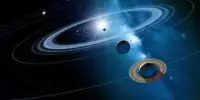MACS J0138.0-2155 is a massive cluster of galaxies discovered by NASA’s James Webb Space Telescope in November 2023. A distant galaxy named MRG-M0138 appears warped by the powerful gravity of the intervening galaxy cluster, as predicted by Albert Einstein. The gravitational lensing effect caused by MACS J0138 produces five different images of MRG-M0138 in addition to warping and magnifying the distant galaxy.
Astronomers announced in 2019 the surprising discovery of a stellar explosion, or supernova, within MRG-M0138, as seen in Hubble Space Telescope images taken in 2016. Another group of astronomers examined the 2023 Webb images and were astounded to discover that the same galaxy is home to a second supernova seven years later.
Justin Pierel (NASA Einstein Fellow at the Space Telescope Science Institute) and Andrew Newman (staff astronomer at the Carnegie Institution for Science Observatories) explain why this is the first time two gravitationally lensed supernovae have been discovered in the same galaxy.
Supernovae are normally unpredictable, but in this case, we know when and where to look to see the final appearances of Requiem and Encore. Infrared observations around 2035 will catch their last hurrah and deliver a new and precise measurement of the Hubble constant.
Justin Pierel
“When a supernova explodes behind a gravitational lens, its light travels to Earth via a variety of paths.” These paths can be compared to several trains leaving a station at the same time, all traveling at the same speed and bound for the same location. Because of differences in trip length and terrain, the trains do not arrive at their destinations at the same time.
Similarly, gravitationally lensed supernova images appear to astronomers over days, weeks, or even years. By measuring differences in the times that the supernova images appear, we can measure the history of the expansion rate of the universe, known as the Hubble constant, which is a major challenge in cosmology today. The catch is that these multiply-imaged supernovae are extremely rare: fewer than a dozen have been detected until now.

“Within this small club, the 2016 supernova Requiem in MRG-M0138 stood out for several reasons.” For starters, it was 10 billion light-years away. Second, the supernova was most likely of the type (Ia) that is used as a ‘standard candle’ to calculate cosmic distances. Third, models predicted that one of the supernova images would be so delayed by its path through the cluster’s extreme gravity that it will not be visible to us until the mid-2030s. Unfortunately, because Requiem was discovered in 2019, long after it had faded from view, there was insufficient data to measure the Hubble constant at the time.
“We have discovered a second gravitationally lensed supernova, Supernova Encore, within the same galaxy as Requiem.” Encore was discovered by chance, and we are now actively tracking the ongoing supernova with a director’s discretionary program. We will measure and confirm the Hubble constant based on this multiply imaged supernova using these Webb images. Encore has been confirmed as a standard candle or type Ia supernova, making Encore and Requiem the most distant pair of standard-candle supernova ‘siblings’ ever discovered.
“Supernovae are normally unpredictable, but in this case we know when and where to look to see the final appearances of Requiem and Encore. Infrared observations around 2035 will catch their last hurrah and deliver a new and precise measurement of the Hubble constant.”
















